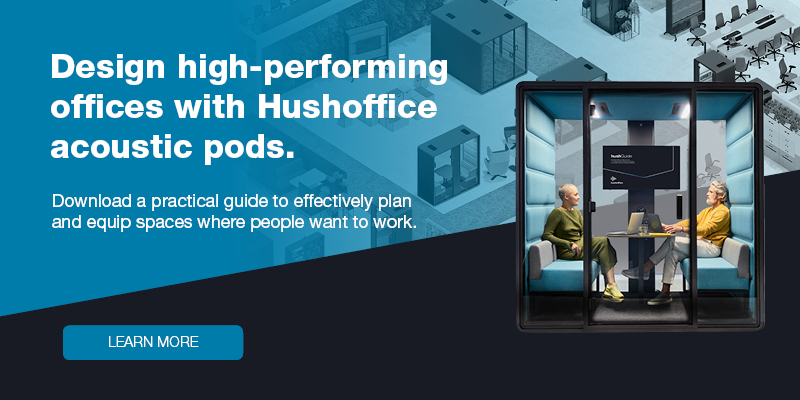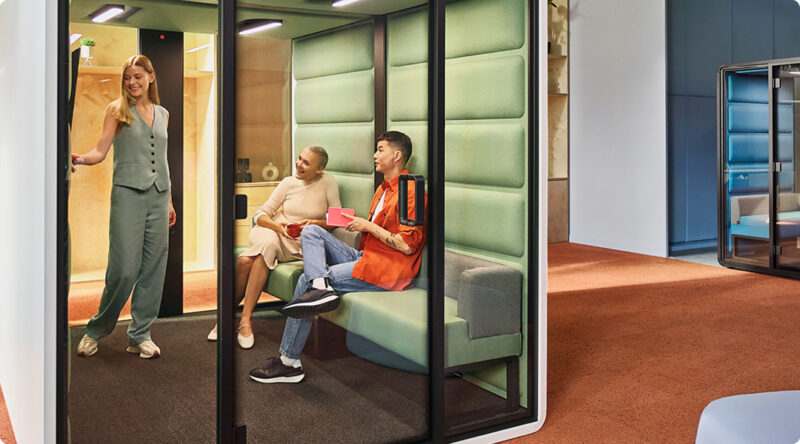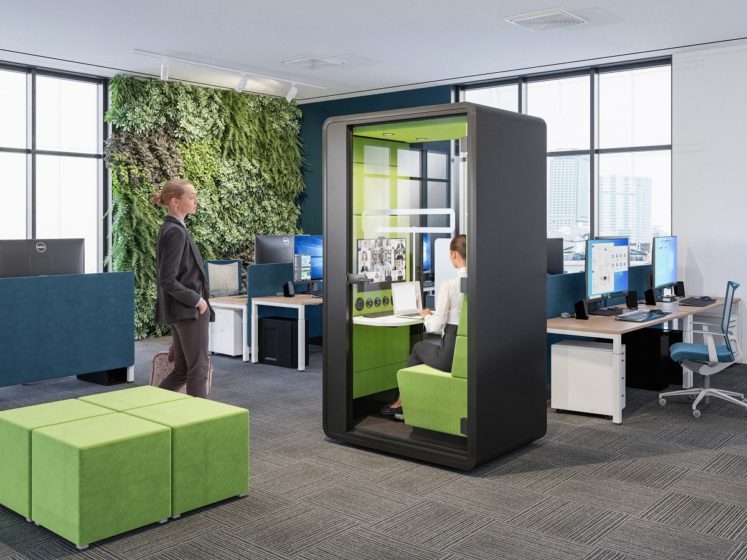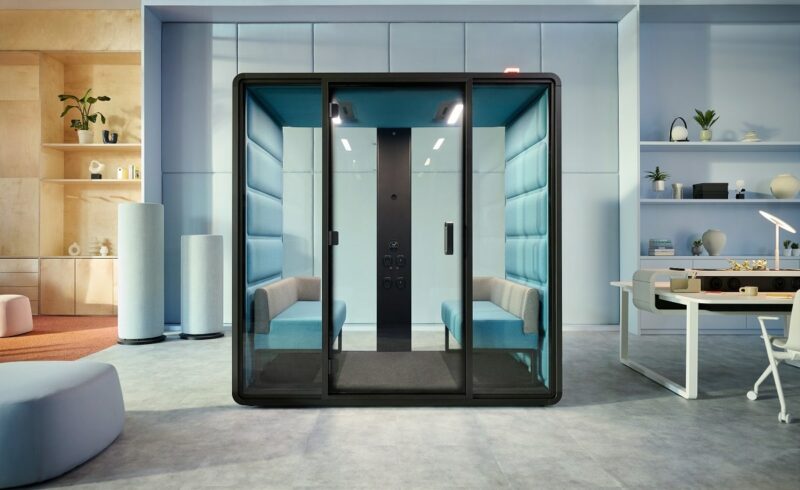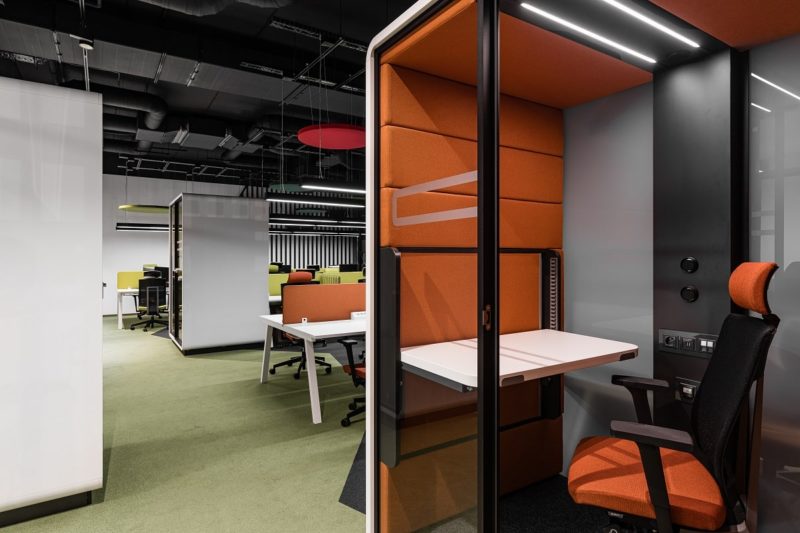Addressing spatial chaos in the office with acoustic booths
- Posted on: 17 May 2024
- By: Hushoffice Team
Just what is spatial chaos in the office and why is it a problem? Let’s clarify this matter as well as the worst contributors to disorder in the workplace.
Spacial chaos – tl;dr
Spatial chaos in the office is just what it sounds like. It is a disorienting landscape that disrupts workflow and undermines productivity. Desks may be cluttered, wayfinding may be unclear, with congested hallways hindering movement, overcrowded workstations may deprive employees of personal space, and noise may pollute the employee’s mental bandwidth.
While visual clutter is the easiest culprit of office chaos to identify and address, wayfinding is a much more nuanced matter. When an office space has good wayfinding, employees easily navigate from zone to zone without confusion or frustration. Noise is arguably the most deleterious culprit of office chaos, because sound affects people in deeply emotional ways. All three elements — clutter, wayfinding, and noise — must be addressed to render a disorderly office space calm and conductive to focus.
Booths are a strong antidote for a chaotic workplace because they cater to all three top sensory elements (clutter, wayfinding, and noise). They are minimally designed, encouraging users to bring only the essential to every meeting or work session. And being mobile while substantial in size, they divide space, allowing teammates to fashion the most intuitive layout. Pods and booths are also acoustic, reducing noise on the office floor.
What is spatial chaos in the office?
Spatial chaos is disorder, disarray, disarrangement, and overall environmental commotion. At work, this looks like overly busy sightlines, confusing or frustrating and congested walkways, distracting acoustics, and cluttered desktops. In one word: restlessness.
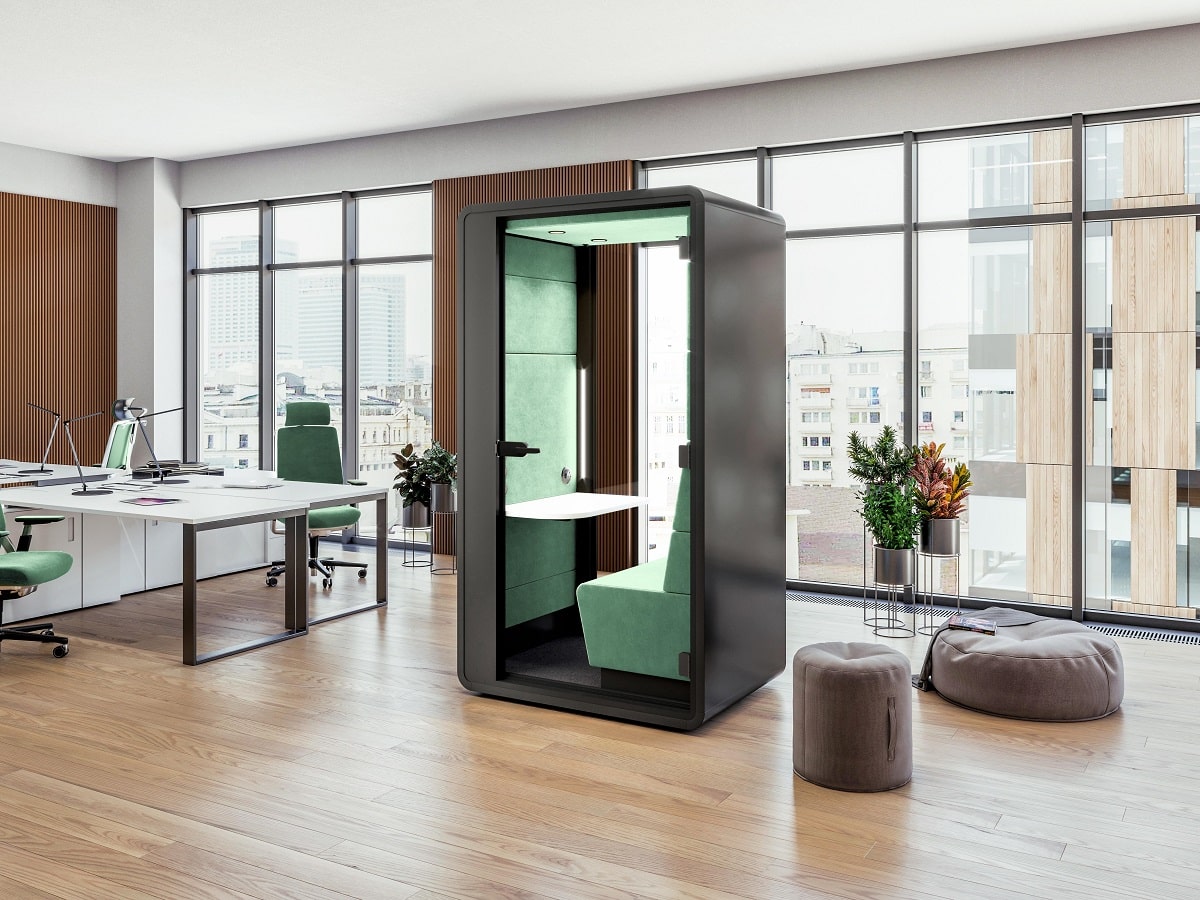
Voices, footsteps, ringing phones — a work symphony or cacophony?
The office’s soundscape is like the mood of its apparent order. Sound is something people physically feel — it is energy, after all, and can be measured and, more immediately, felt. When the office’s acoustics are right, employees feel at ease and able to focus and collaborate smoothly.
Chaos takes many forms, but noise is uniquely psychological, earning special focus. When the office’s background sounds of colleague discussion, breakouts, and device notifications blend into a relatively gentle ambiance, it is soothing and unobtrusive. The space feels like elevator music. It conducts productivity, so to say. But when these sounds are too loud, clashing, or unpredictable, the environment is counterproductive. As always, employee opinion will be your best indicator of whether the office feels harmonious or haphazard to focus by measure of sound, for they are the ones viscerally experiencing the floor each day. And ultimately, the smartest approach to fine-tuning the office’s acoustics will provide for a variety of zones each with distinct sound attributes. The varied landscape you create may include a private booth for impenetrable focus, for instance, giving balance to the more bustling areas like the cafe or work lounge, and so on. Through deliberate variety, unsettling chaos can be rendered functional order, zone by zone, acoustically and otherwise
– says Mateusz Barczyk, Senior Brand Manager, Hushoffice.
Our brains like calm and continuity best.
Princeton University’s Neuroscience Institute has proven that our brains decidedly prefer order. As such, chaos, visual or auditory, taxes our mental resources, hindering the capacity to concentrate. When employees simply declutter their desks, for example, productivity is expected to increase.
Office chaos results from a lack of order in the layout.
Spatial order means high aesthetics. Attractiveness and modernity. Practical factors such as functionality, readability, and clarity of structures must also be met. And efficiency must permeate every zone — each area is set up and furnished for a desirable balance between compactness and emptiness.

Visual clutter, just one clear element of spatial chaos, harms employee efficiency.
It is no surprise that visual clutter is proven to negatively impact judgment performance and information processing. This means that clutter in all its forms, from messy storage to jumbled furniture arrangements, can increase judgment errors, causing employees to make more mistakes.
Clutter hurts mental health, too. In excess, it is plain overwhelming.
The good news here is that the process of simply tidying one’s workspace can clear their mind. Tidiness in this form is shown to reduce stress and anxiety, improving concentration on tasks. A streamlined workspace is indeed free of visual distractions and lets employees focus on their work.
- 40% of employees say an untidy workplace makes them less productive
- 49% of employees say office messiness influences how they feel about going into work each day
- Workers with tidy desks are in control, more productive, and happier

Wayfinding shapes the office’s order, proving integral to employee well-being.
Bad wayfinding is physically and psychologically harmful. It can create confusion, frustration, stress, and even physical woes like headaches. Alternatively, the clear signage, floor plans, and landmarks of good wayfinding make for a well-ordered, navigable space people find harmony within.
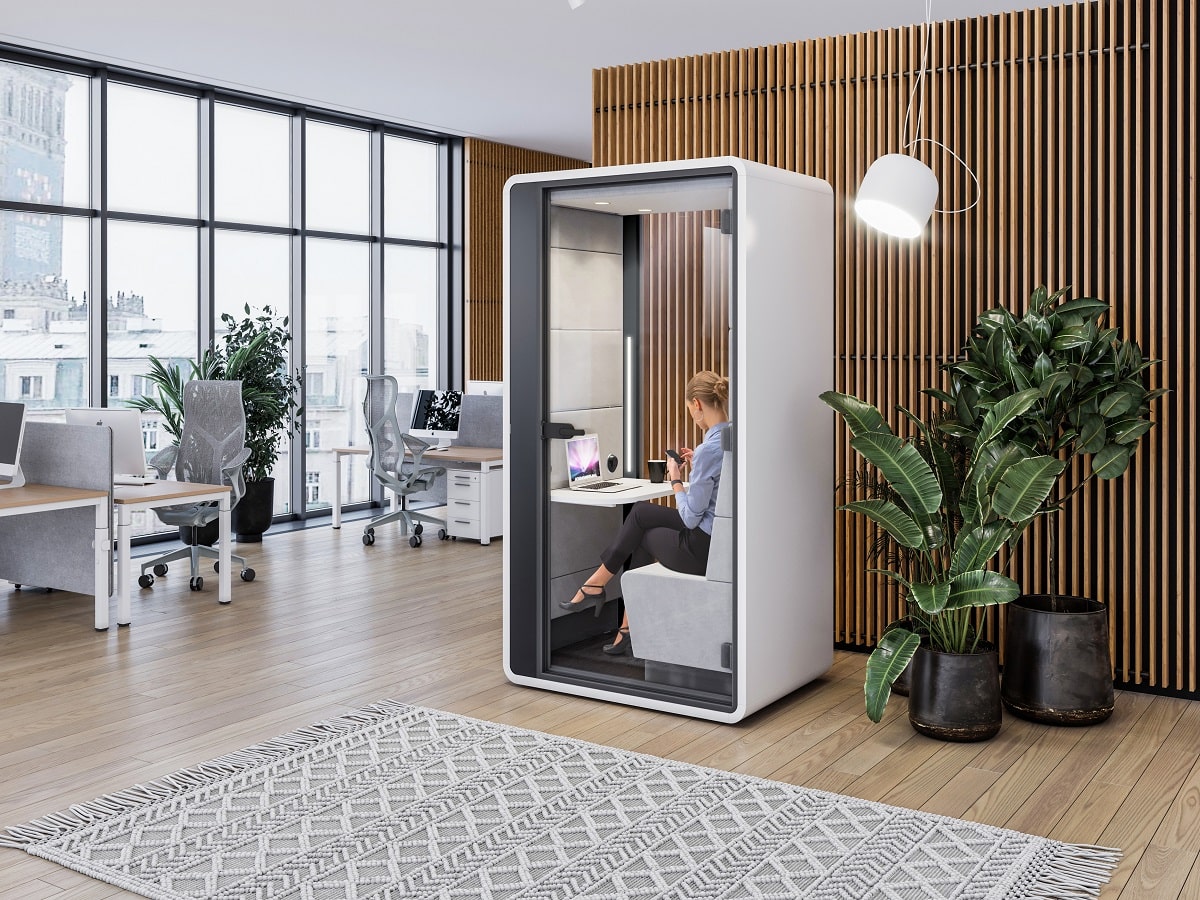
Noise is the ultimate “chaos” variable, interfering with cognition in serious ways.
Noise puts the body in an arousal state, increasing stress hormone levels. As the brain is forced to spend extra resources filtering out distracting sound, less resources are available to complete work tasks. A decline in cognitive performance follows.
Offices must be planned (and organized) with acoustics in mind to work well.
For many teams, clutter is the most obvious cause of office chaos, being plain to see. Wayfinding is less apparent, as it casually shapes flow or friction for employees navigating their space. The third and arguably most important factor, for how emotionally it affects us, is acoustics.
Pods are premium spatial solutions that turn chaos into calm, starting with sound.
A booth divides space while creating a new one — space within a space, that is. They insulate user noise, sparing employees on the floor of calls, meetings, and so on. And they are supremely private, limiting peripheral activities, while cocooning you in an uncluttered, coherent environment.
Isolation v. integration. Booths add to the office’s variety of sensory scapes.
Booths are a favorable way to give the office order. Acoustically, above all else, being self-contained quiet dens where concentration is unchallenged. While the floor ebbs and flows, a booth is a stable place of seclusion. It diversifies the office’s range of work settings.
Beyond strict sound-insulation. Pods offer elevated, professional acoustics.
Booths like Hushoffice are finely engineered to be quiet but not too quiet. From inside, floor noise is heard as a soft if not soothing murmur. This means you don’t feel strangely isolated in an office pod but supported by its perfect degree of quietude.
Not just about quiet. Pods and booths master functionality and comfort, too.
A high-quality office cabin will feature adjustable lighting and ventilation. Visual and thermal ease are indeed overlooked but critical aspects of ergonomics and, most simply, employee comfort. A quality pod will also have the right furniture and features for convenient working.
Hushoffice acoustic cabins divide space while creating it (space-within-a-space).
Pods are a smart spatial solution because they can be easily relocated. They are substantial structures, too, so relocating them significantly alters the office layout, allowing you to make adjustments without fuss, all the while enjoying the dependable function and perfect space each pod provides.
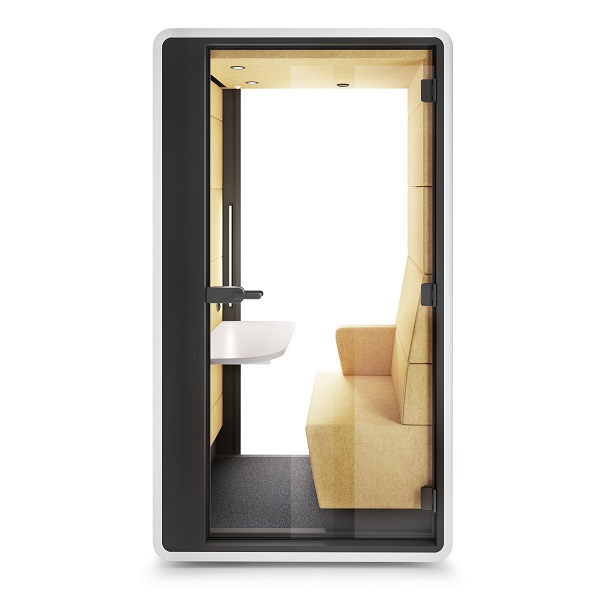
Zone #1: Quiet, focused, independent effort in hushHybrid.
If your team needs a fully equipped, all-in-one video call booth, hushHybrid may be the booth for you. It features tweakable lights in addition to extra video light strips for excellent facial-expression readability.
Zone #2: Meetings and creative work in hushMeet.
Fighting over limited meeting rooms? Consider the hushMeet 4-person meeting pod — a flexible alternative to inflexible construction. HushMeet guarantees speech privacy through its careful acoustic design.
Zone #3: Rest and regeneration in hushAccess.L.
Rest is integral to work performance. A cozy, multi-person booth like hushAccess.L makes a great break room because it is large enough to be furnished with soft seating and a sizable TV monitor, letting teammates kick back.
Visions of the future — how do acoustic booths shape trends in office design?
Pods evolve the office by giving it more truly differentiated variety. They allow the people who thrive in sensory deprivation to get it in a booth, while letting extroverts thrive in the floor’s enduring bustle. While the floor ebbs and flows, pods remain steady oases of pure calm, always at hand for those who need it. By this token, they evolve the workplace, better catering to individual preferences, giving employees the autonomy they need to find their groove by going to the right booth. Clutter-free by design, they set a tone of streamlined focus, as well, encouraging employees to come and go with minimal clutter themselves. They are solid structures and mobile, allowing an organization to alter their layout for the most natural wayfinding, a key component of an office’s spatial order. Most importantly, booths get a real handle on noise, addressing and enhancing the most emotionally influential aspect of a space’s sense of functional coherence
– says Mateusz Barczyk, Senior Brand Manager, Hushoffice.
Check out the Hushoffice collection here.
Spatial chaos – summarized
Spatial chaos in the office is just what it sounds like. It is a disorienting landscape that disrupts workflow and undermines productivity. Desks may be cluttered, wayfinding may be unclear, with congested hallways hindering movement, overcrowded workstations may deprive employees of personal space, and noise may pollute the employee’s mental bandwidth.
While visual clutter is the easiest culprit of office chaos to identify and address, wayfinding is a much more nuanced matter. When an office space has good wayfinding, employees easily navigate from zone to zone without confusion or frustration. Noise is arguably the most deleterious culprit of office chaos, because sound affects people in deeply emotional ways. All three elements — clutter, wayfinding, and noise — must be addressed to render a disorderly office space calm and conductive to focus.
Booths are a strong antidote for a chaotic workplace because they cater to all three top sensory elements (clutter, wayfinding, and noise). They are minimally designed, encouraging users to bring only the essential to every meeting or work session. And being mobile while substantial in size, they divide space, allowing teammates to fashion the most intuitive layout. Pods and booths are also acoustic, reducing noise on the office floor.
Spatial chaos – frequently asked questions
What is spatial chaos in the office?
Some components of spatial chaos in the office include clutter, congestion, noise pollution, lack of personal space, and poor lighting or ventilation. Spatial chaos is not merely a visual spectacle but a tangible barrier to efficiency and well-being, demanding proactive measures to restore order and harmony in the workplace.
How do I make the office calmer?
To give a tumultuous office more order, try focusing on the three influential elements: clutter, wayfinding, and office noise.
How does noise impact employee focus?
Loud noises can put the body in an arousal state. This increases stress hormone levels like cortisol, forcing the brain to filter out the sound, which recruits extra resources. What this means is that there are less mental resources available for basic tasks, causing a decline in productivity.

